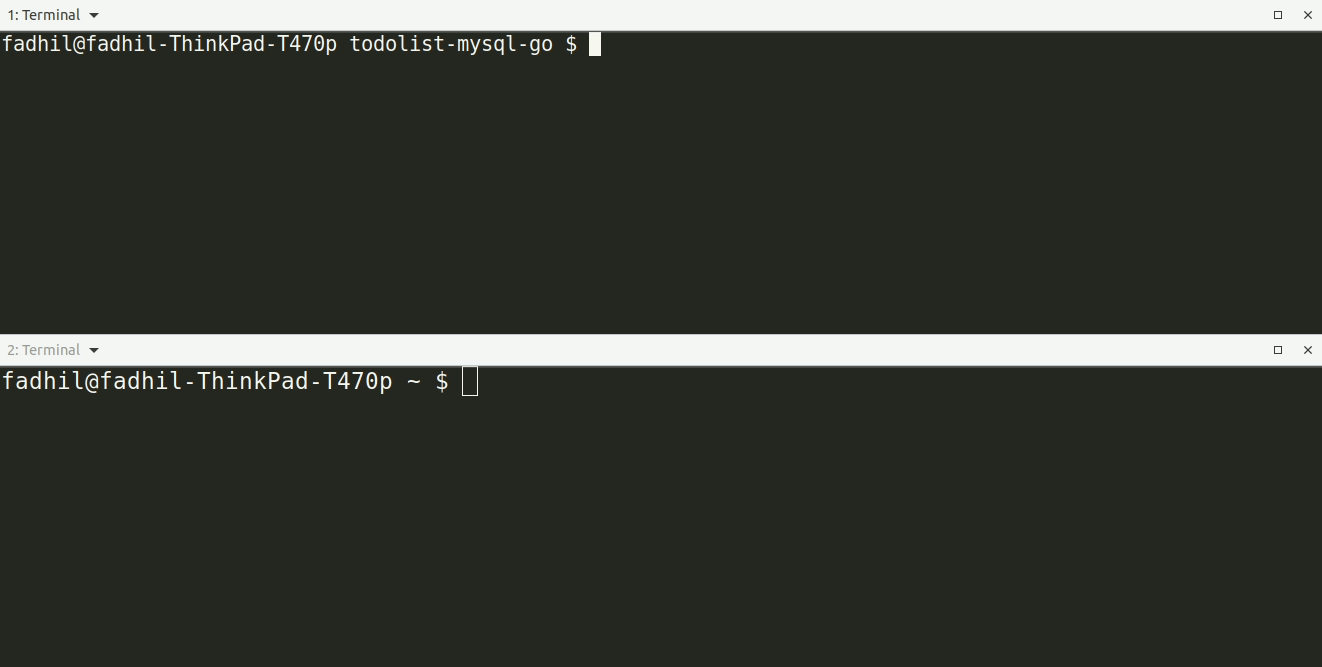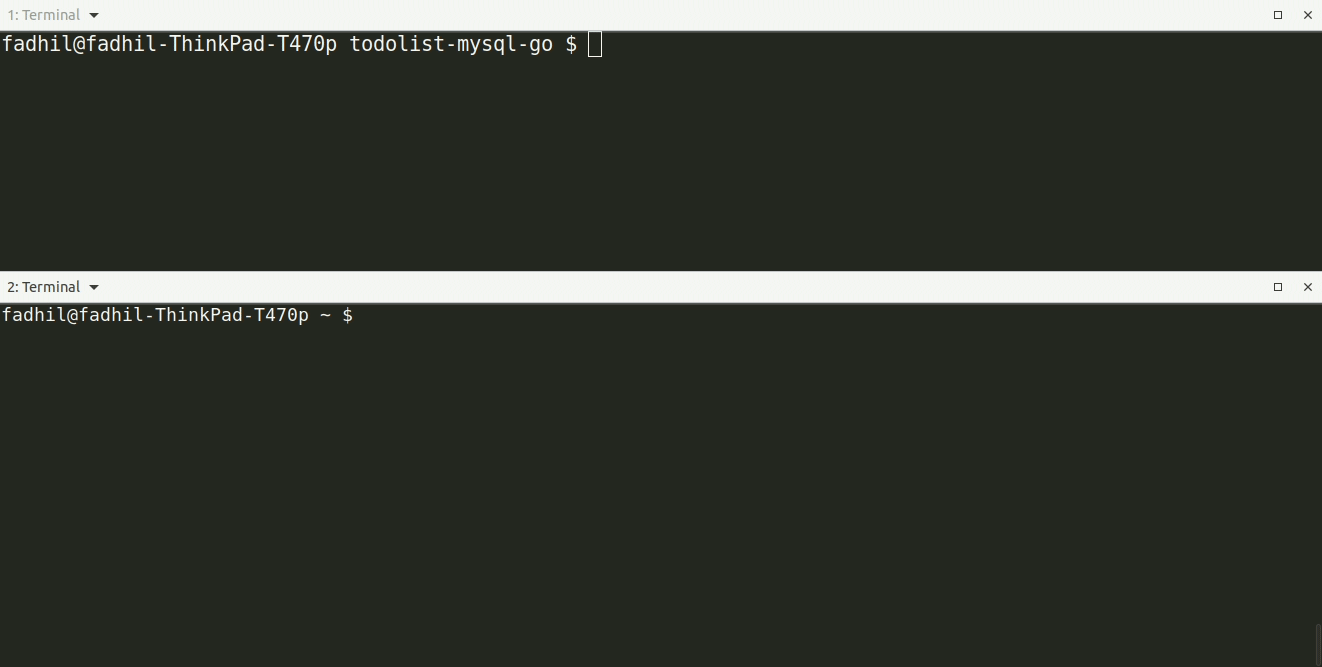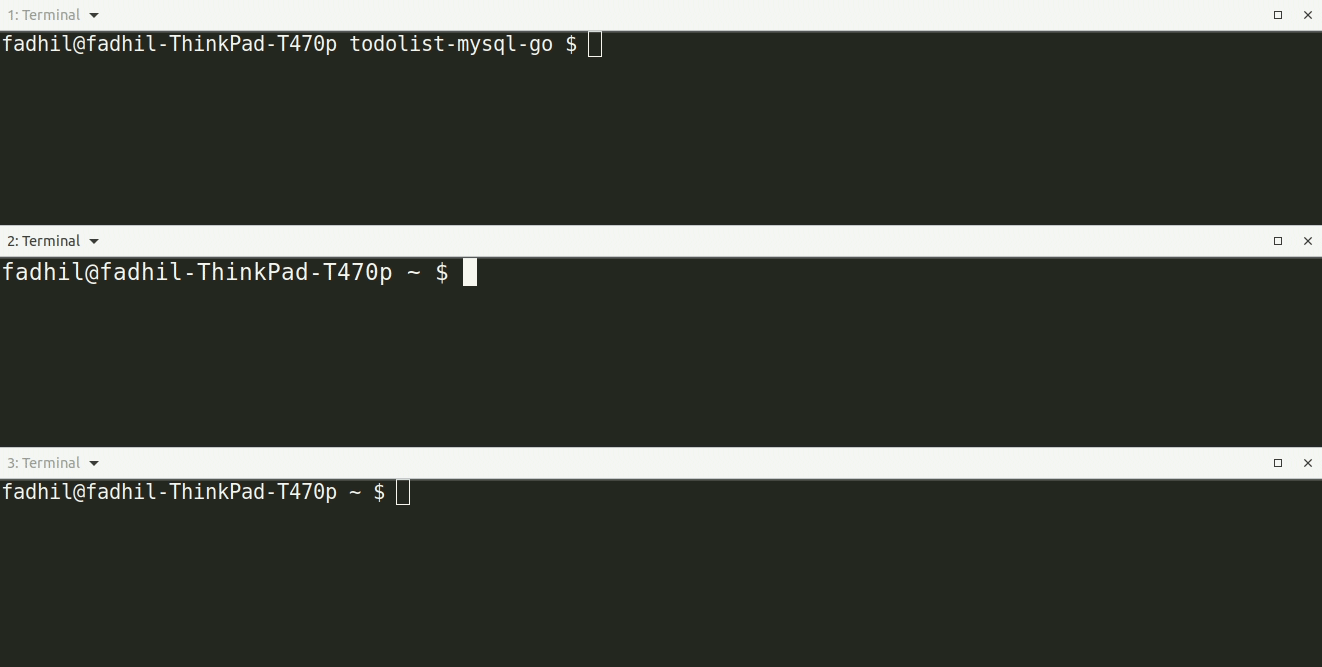Build a Todolist API Server in Golang
I always wanted to learn Golang for a long time. According to the StackOverflow survey, Golang is the 3rd most wanted programming language in the year 2019. Coming from a Python background, learning a new programming language like Golang gives me a unique perspective on how to write code. I was inspired by a helpful tutorial post by Keiran Scot. The following tutorial is heavily influenced by Keiran’s tutorial but made to use MySQL instead of Mongo as part of my exercise to learn Golang.
Personally, I believe Golang is the new Java, where many open source projects (e.g., Jaeger, Kubernetes, Docker, InfluxDB, Serf, etc.) are now written in Golang. In contrast, the older projects (e.g., Apache Kafka, Apache Hadoop, Apache Spark, etc.) are written in Java. I wish I could participate and contribute to OSS Golang projects in the future.
There are many advantages of Golang compared to other languages, including:
- Golang is blazing fast
See it yourself https://benchmarksgame-team.pages.debian.net/benchmarksgame/fastest/go.html - Golang is built for concurrency
Golang comes with Goroutine that is made to tackle this problem. I was mesmerized with this feature when I first learned about Golang. Unfortunately, we won’t be seeing how goroutine works in this in this tutorial yet. - Golang is statically typed language Coming from a Python background, I find this feature in Golang is a bit irritating at first. However, writing in statically type programming language means that you’ll introduce fewer bugs because you’ll make lesser mistakes on interpreting and passing the data.
- Go compiles the program into a single binary
When you’re building an application in Go, you can always run your everywhere. You do not have to worry about its dependencies, because all of them are bundled together. - Golang is an opinionated language
There is a rigorous way on how to write a Golang code. This means there is less variation on how people should write code in Golang, which eventually implies code consistency, readability, and maintainability. For a big and complex project, this is very helpful. - You can read here more about its advantages.
Prerequisites
I have prepared a frontend part for this app, so you don’t have to worry about this and focus on writing the Golang code. All you need is clone the repository in Step #7.
What we’ll build
We will build a classic and simple Golang API server that connects to a Frontend page. Our Golang API server will use:
- MySQL as our database
- GORM as ORM to interacting with our database
- Request router using
gorilla/mux - Logrus for logging
How our entire app will work#

We will be building what’s on the right side of the diagram. The specifications for our API Server are:
- It listens to port 8000 on localhost
- It has 5 endpoints:
healthz,createItem,getCompletedItems,getIncompleteItems,updateItemanddeleteItem - TodoItem model consists of Id, Description and Completed status attributes.
The web frontend that I have prepared will execute AJAX requests to localhost:8000 for all operations. Check this JS script to see how it works first. The initial code was made by themaxsandelin.
Let’s begin
Step 1: Bootstrap a project#
First, let’s create a new directory and install gorilla/mux and logrus packages in the directory
$ mkdir todolist-mysql-go
$ cd todolist-mysql-go
$ go get -u github.com/gorilla/mux
$ go get -u github.com/sirupsen/logrus
Now createtodolist.go file with the following content:
package main
import (
"io"
"net/http"
"github.com/gorilla/mux"
log "github.com/sirupsen/logrus"
)
func Healthz(w http.ResponseWriter, r *http.Request) {
log.Info("API Health is OK")
w.Header().Set("Content-Type", "application/json")
io.WriteString(w, `{"alive": true}`)
}
func init() {
log.SetFormatter(&log.TextFormatter{})
log.SetReportCaller(true)
}
func main() {
log.Info("Starting Todolist API server")
router := mux.NewRouter()
router.HandleFunc("/healthz", Healthz).Methods("GET")
http.ListenAndServe(":8000", router)
}
In lines 3 to 8, we are importing all the necessary packages we get in our previous go get -u commands. Beware that you will get a compilation error when importing any package in Go code without actually using it.
In lines 10 to 14, we created Healthz function that will respond {"alive": true} to the client every time it’s invoked.
In lines 16 to 19, we set our init function to set up our logrus logger settings. In Golang, init() will be executed when the program first begins. You can read more here
In lines 21 to 26, we are initializing our gorilla/mux HTTP router with a walrus operator. We route /healthz HTTP GET requests to Health()function. The router will listen to port 8000.
It’s important to set the Content-Type: application/json so that the client software understands the response.
Simple enough, right? Let’s see what we’ve got so far.

Great! Our first endpoint is now live!
Step 2: Connect to MySQL DB#
Before connecting our Go app to the MySQL database, first, we’ll need to have our MySQL server up. We’ll be using Docker in this case to launch a MySQL container and expose the port 3306 to the localhost. We will create a todolist database in the MySQL container.
$ docker run -d -p 3306:3306 --name mysql -e MYSQL_ROOT_PASSWORD=root mysql
$ docker exec -it mysql mysql -uroot -proot -e 'CREATE DATABASE todolist'
Back to our Go app, we’ll need to install the GORM libraries and dialects.
$ go get -u github.com/jinzhu/gorm
$ go get -u github.com/go-sql-driver/mysql
$ go get -u github.com/jinzhu/gorm/dialects/mysql
Add these lines in our todolist.go code:
package main
import (
"io"
"net/http"
"github.com/gorilla/mux"
log "github.com/sirupsen/logrus"
+ _ "github.com/go-sql-driver/mysql"
+ "github.com/jinzhu/gorm"
+ _ "github.com/jinzhu/gorm/dialects/mysql"
)
+var db, _ := gorm.Open("mysql", "root:root@/todolist?charset=utf8&parseTime=True&loc=Local")
...
func main() {
+ defer db.Close()
log.Info("Starting Todolist API server")
router := mux.NewRouter()
router.HandleFunc("/healthz", Healthz).Methods("GET")
http.ListenAndServe(":8000", router)
}
Add our new imports into the import list in lines 8 to 10. In Golang, if you do not intend to use the variable, you have to name it _ . You can read more here
Next, we will initialize our MySQL connection to our database using GORM. The following lines are to check if there is an error connecting to the database. If there is, log it.
defer db.Close() means we will close our database connection when our main() function is returned.
Step 3: Auto migrate TodoItem ORM Model#
GORM comes with a neat database auto-migration feature where it will create a database table based on your struct definition in the code.
Our TodoItem struct will consist of:
- Id: int. This will be our primary_key
- Description: string. This is what we will display in our Frontend UI
- Completed: boolean. This is to determine if the todo item is done or not.
Add these lines to your Go code:
package main
...
var db, _ := gorm.Open("mysql", "root:root@/todolist?charset=utf8&parseTime=True&loc=Local")
+type TodoItemModel struct{
+ Id int `gorm:"primary_key"`
+ Description string
+ Completed bool
+}
...
func main() {
defer db.Close()
+ db.Debug().DropTableIfExists(&TodoItemModel{})
+ db.Debug().AutoMigrate(&TodoItemModel{})
+
log.Info("Starting Todolist API server")
router := mux.NewRouter()
router.HandleFunc("/healthz", Healthz).Methods("GET")
http.ListenAndServe(":8000", router)
}
In lines 7 to 11, we are defining the TodoItem model as what we described earlier. Everything here is self-explanatory.
In lines 19 and 20, we are running Auto-migration against our MySQL database immediately after starting our API server. See it in action here:

Yeay our database is ready!
Step 4: Create Todo Item operation#
Add the following lines in our todolist.go :
package main
import (
"io"
"net/http"
"github.com/gorilla/mux"
log "github.com/sirupsen/logrus"
_ "github.com/go-sql-driver/mysql"
"github.com/jinzhu/gorm"
_ "github.com/jinzhu/gorm/dialects/mysql"
+ "encoding/json"
)
...
+func CreateItem(w http.ResponseWriter, r *http.Request) {
+ description := r.FormValue("description")
+ log.WithFields(log.Fields{"description": description}).Info("Add new TodoItem. Saving to database.")
+ todo := &TodoItemModel{Description: description, Completed: false}
+ db.Create(&todo)
+ result := db.Last(&todo)
+ w.Header().Set("Content-Type", "application/json")
+ json.NewEncoder(w).Encode(result.Value)
+}
...
log.Info("Starting Todolist API server")
router := mux.NewRouter()
router.HandleFunc("/healthz", Healthz).Methods("GET")
+ router.HandleFunc("/todo", CreateItem).Methods("POST")
http.ListenAndServe(":8000", router)
}
On line 16, we obtain the value from POST operation with r.FormValue("parameter") . We use the value as the description to insert into our database. After that, we create todo object and persist it in our database. Lastly, we query the database and return the query result to the client to make sure that the operation is success.
Inline 32, we register the new route /todo with HTTP POST request into our new CreateItem() function.

Step 5: Continue with the rest of CRUD operations#
Let’s continue with the rest of Read, Update, and Delete operations.
import (
"io"
"net/http"
"github.com/gorilla/mux"
log "github.com/sirupsen/logrus"
_ "github.com/go-sql-driver/mysql"
"github.com/jinzhu/gorm"
_ "github.com/jinzhu/gorm/dialects/mysql"
"encoding/json"
+ "strconv"
)
...
+func UpdateItem(w http.ResponseWriter, r *http.Request) {
+ // Get URL parameter from mux
+ vars := mux.Vars(r)
+ id, _ := strconv.Atoi(vars["id"])
+
+ // Test if the TodoItem exist in DB
+ err := GetItemByID(id)
+ if err == false {
+ w.Header().Set("Content-Type", "application/json")
+ io.WriteString(w, `{"updated": false, "error": "Record Not Found"}`)
+ } else {
+ completed, _ := strconv.ParseBool(r.FormValue("completed"))
+ log.WithFields(log.Fields{"Id": id, "Completed": completed}).Info("Updating TodoItem")
+ todo := &TodoItemModel{}
+ db.First(&todo, id)
+ todo.Completed = completed
+ db.Save(&todo)
+ w.Header().Set("Content-Type", "application/json")
+ io.WriteString(w, `{"updated": true}`)
+ }
+}
+
+func DeleteItem(w http.ResponseWriter, r *http.Request) {
+ // Get URL parameter from mux
+ vars := mux.Vars(r)
+ id, _ := strconv.Atoi(vars["id"])
+
+ // Test if the TodoItem exist in DB
+ err := GetItemByID(id)
+ if err == false {
+ w.Header().Set("Content-Type", "application/json")
+ io.WriteString(w, `{"deleted": false, "error": "Record Not Found"}`)
+ } else {
+ log.WithFields(log.Fields{"Id": id}).Info("Deleting TodoItem")
+ todo := &TodoItemModel{}
+ db.First(&todo, id)
+ db.Delete(&todo)
+ w.Header().Set("Content-Type", "application/json")
+ io.WriteString(w, `{"deleted": true}`)
+ }
+}
+func GetItemByID(Id int) bool {
+ todo := &TodoItemModel{}
+ result := db.First(&todo, Id)
+ if result.Error != nil{
+ log.Warn("TodoItem not found in database")
+ return false
+ }
+ return true
+}
+
+func GetCompletedItems(w http.ResponseWriter, r *http.Request) {
+ log.Info("Get completed TodoItems")
+ completedTodoItems := GetTodoItems(true)
+ w.Header().Set("Content-Type", "application/json")
+ json.NewEncoder(w).Encode(completedTodoItems)
+}
+
+func GetIncompleteItems(w http.ResponseWriter, r *http.Request) {
+ log.Info("Get Incomplete TodoItems")
+ IncompleteTodoItems := GetTodoItems(false)
+ w.Header().Set("Content-Type", "application/json")
+ json.NewEncoder(w).Encode(IncompleteTodoItems)
+}
+
+func GetTodoItems(completed bool) interface{} {
+ var todos []TodoItemModel
+ TodoItems := db.Where("completed = ?", completed).Find(&todos).Value
+ return TodoItems
}
...
log.Info("Starting Todolist API server")
router := mux.NewRouter()
router.HandleFunc("/healthz", Healthz).Methods("GET")
+ router.HandleFunc("/todo-completed", GetCompletedItems).Methods("GET")
+ router.HandleFunc("/todo-incomplete", GetIncompleteItems).Methods("GET")
router.HandleFunc("/todo", CreateItem).Methods("POST")
router.HandleFunc("/todo/{id}", UpdateItem).Methods("POST")
+ router.HandleFunc("/todo/{id}", DeleteItem).Methods("DELETE")
http.ListenAndServe(":8000", router)
}
We should be able to perform Create, Read, Update, and Delete operations on the TodoItems.
In order to update a TodoItem object, we will first query our database to ensure that the item actually exists. I created a function GetItemById() for this purpose. The equivalent SQL query is SELECT * FROM todo_item_models WHERE Id = <Id> LIMIT 1; .
Both UpdateItem() and DeleteItem() functions will invoke GetItemById()first before actually update or delete them.
Notice that I imported strconv package in there. The package is used to convert String variable into Integer before we run the SQL queries.
The GetCompletedItems() and GetIncompletedItems() functions are self-explanatory as well. It will execute SQL Select query and encode them into JSON before returning them to the client.
Step 6: Connect with Frontend#
In order to connect the API server to the frontend page, we need to give the CORS headers to the response. CORS is a mechanism that allows restricted resources on a web page to be requested from another domain outside the domain from which the first resource was served.
To do so, you’ll need to install the go cors package
$ go get -u github.com/rs/cors
Add these lines to your Go code:
package main
import (
"io"
"net/http"
"github.com/gorilla/mux"
log "github.com/sirupsen/logrus"
_ "github.com/go-sql-driver/mysql"
"github.com/jinzhu/gorm"
_ "github.com/jinzhu/gorm/dialects/mysql"
"encoding/json"
"strconv"
+ "github.com/rs/cors"
)
...
log.Info("Starting Todolist API server")
router := mux.NewRouter()
router.HandleFunc("/healthz", Healthz).Methods("GET")
router.HandleFunc("/todo-completed", GetCompletedItems).Methods("GET")
router.HandleFunc("/todo-incomplete", GetIncompleteItems).Methods("GET")
router.HandleFunc("/todo", CreateItem).Methods("POST")
router.HandleFunc("/todo/{id}", UpdateItem).Methods("POST")
router.HandleFunc("/todo/{id}", DeleteItem).Methods("DELETE")
- http.ListenAndServe(":8000", router)
+
+ handler := cors.New(cors.Options{
+ AllowedMethods: []string{"GET", "POST", "DELETE", "PATCH", "OPTIONS"},
+ }).Handler(router)
+
+ http.ListenAndServe(":8000", handler)
}
In lines 28 to 32, we’re wrapping CORS handler around our existing application.
Now clone my frontend site for this Go app.
$ git clone [git@github.com](mailto:git@github.com):sdil/todo.git
Then open index.html page in your browser. There is nothing special in this simple JQuery page. I have modified the original code made by themaxsandelin to execute AJAX requests when you click buttons in the page. Check resources/js/main.js file to see how the web frontend works.
Step 7: Build the package#
Now we’re done with our coding. You can now compile your code.
$ go build
$ ./todolist-mysql-go
Voila!! A little end-to-end demonstration#
Congratulations, you’ve built yourself a Todolist in Golang!!
You can find the full source code in my Github repository. If you’re stuck at any point in this tutorial, feel free to refer there
Don’t Stop Learning#
This is an, in fact, a tiny part of Golang. There are many more things that you can explore next in Golang. You’ll have more reason to love Golang. I hope this tutorial inspired you to go explore more :D